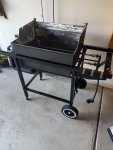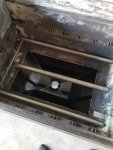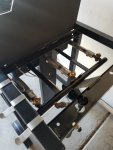About the broken bolt...finesse is hard to explain, but if it were me I would try heating the area around the broken bolt with a propane torch. Aluminum melts at around 1200*, much lower than steel, but the tragic thing is that it doesn't change color before it melts. Aluminum also expands at a higher rate than steel, so heating usually works pretty well...but you have to use common sense and not cause damage. If you have a punch, not a center punch but a pin punch, you can heat the surrounding area with a torch and try tapping on that broken bolt with a hammer and a punch. Larry says these fireboxes are prone to shattering, and I believe him, so try gently tapping and see if it has an effect. You are trying to coax it out, not hammer it out. If you don't see anything happening, no progress or movement with the tapping, don't keep hitting it until something does happen...let it cool down and drill it out.
EDIT: If you can back it up, bracing the back side by standing it on a pile of lumber, so that you are only applying force to a small isolated area instead of the whole side of the box, all the better. It's a risk, though, so if you are more comfortable drilling, then drill away!



